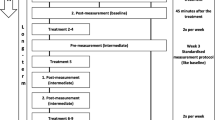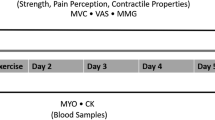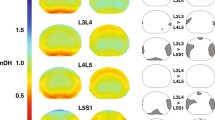Abstract
Repetitive or overuse disorders of the lumbar spine affect the lives of workers and athletes. We hypothesize that repetitive anterior lumbar flexion–extension under low or high load will result in significantly elevated pro-inflammatory cytokines expression several hours post-activity. High loads will exhibit significantly higher expression than low loads. Lumbar spine of in vivo feline was subjected to cyclic loading at 0.25 Hz for six 10-min periods with 10 min of rest in between. One group was subjected to a low peak load of 20 N, whereas the second group to a high peak load of 60 N. Following a 7-h post-loading rest, the supraspinous ligaments of L-3/4, L-4/5 and L-5/6 and the unstimulated T-10/11 were excised for mRNA analysis and IL-1β, IL-6, IL-8, TNFα and TGFβ1 pro-inflammatory cytokines expression. Creep (laxity) developed in the lumbar spine during the loading and the subsequent 7 h of rest was calculated. A two-way mixed model ANOVA was used to assess difference in each cytokines expression between the two groups and control. Tukey HSD post hoc analysis delineated specific significant effects. Significance was set at 0.05. Low and high-load groups exhibited development of creep throughout the cyclic loading period and gradual recovery throughout the 7-h rest period. Residual creep of 24.8 and 30.2% were present in the low and high-load groups, respectively, 7-h post-loading. Significant increases in expression of all cytokines measured relative to control were obtained for supraspinous ligaments from both low and high-load magnitudes. IL-6, IL-8 and TGFβ1 expression in the high-load group were significantly higher relative to the low-load group. Significant increases in cytokines expression indicating tissue inflammation are observed several hours post-repetitive lumbar flexion–extension regardless of the load magnitude applied. Repetitive occupational and athletic activity, regardless of the load applied, may be associated with the potential of developing acute inflammatory conditions that may convert to chronic inflammation if the viscoelastic tissues are further exposed to repetitive activity over long periods. Appropriate rest periods are a relevant preventive measure.




Similar content being viewed by others
References
Barbe M, Barr A, Gorzelany I et al (2003) Chronic repetitive reaching and grasping results in decreased motor performance and widespread tissue responses in rat model of MSD. J Orthop Res 21:167–176
Ben-Masaud A, Solomonow D, Davidson B, Zhou B, Lu Y, Patel V, Solomonow M (2009) Motor control of lumbar instability following exposure to various cyclic load magnitudes. Eur Spine J 18:1022–1034
Cohen J (1988) Statistical power analysis for the behavioral sciences, 2nd edn. Routledge Academic press, London
Crisco J, Chelikani S, Brown R, Wolfe S (1997) The effect of exercise on ligamentous stiffness in the wrist. J Hand Surg 22A:44–48
Dickey J, McNorton S, Potvin J (2003) Repeated spinal flexion modulates the flexion–relaxation phenomenon. Clin Biomech 18:783–789
Duenwald S, Vanderby R, Lakes R (2009) Viscoelastic relaxation and recovery of tendons. Ann Biomed Eng 37:1131–1140
Fung D, Wang V, Laudier D, Shine J, Basta-Pljakic J, Jepesen K, Schaffler M, Flatow E (2009) Subrupture tendon fatigue damage. J Orthopedic Res 27:264–273
Gauldie J, Sauder DN, McAdam KP, Dinarello CA (1987) Purified interleukin-1 (IL-1) from human monocytes stimulates acute-phase protein synthesis by rodent hepatocytes in vitro. Immunology 60(2):203–207
Guerne PA, Zuraw BL, Vaughan JH, Carson DA, Lotz M (1989) Synovium as a source of interleukin 6 in vitro contribution to local and systemic manifestations of arthritis. J Clin Invest 83(2):585–592
Hoogendoorn WE, Bongers PM, de Vet HC et al (2000) Flexion and rotation of the trunk and lifting at work are risk factors for low back pain: results of a prospective cohort study. Spine 25:3087–3092
Hoops H, Zhou B, Lu Y, Solomonow M, Patel V (2007) Short rest between cyclic flexion periods is a risk factor for lumbar disorder. Clin Biomech 22:745–757
King K, Davidson B, Zhou B, Lu Y, Patel V, Solomonow M (2009) High magnitude cyclic load triggers inflammatory response in lumbar ligaments. Clin Biomech 24:792–798
Le P, Solomonow M, Zhou B, Lu Y, Patel V (2007) Cyclic load magnitude is a risk factor for cumulative low back disorder. J Occup Environ Med 49:375–387
Leadbetter W (1990) An introduction to sports induced soft tissue inflammation. In: Leadbetter W, Buckwalter J, Gordon S (eds) Sports induced inflammation; clinical and basic science concepts. Am. Acad. Orthopedic Surgeons, Park Ridge
Li L, Patel N, Solomonow D, Le P, Hoops H, Gerhardt D, Johnson K, Zhou B, Lu Y, Solomonow M (2007) Neuromuscular response to cyclic lumbar twisting. Hum Factors 49:820–829
Lipsky PE (2006) Interleukin-6 and rheumatic diseases. Arthritis Res Ther 8 (suppl 2):S4
Little J, Khalsa P (2005) Human lumbar spine creep during cyclic and static flexion: creep rate, biomechanics, and facet joint capsule strain. Ann Biomed Eng 33:391–401
Lu D, Solomonow M, Zhou B, Baratta R, Li L (2004) Frequency dependent changes in neuromuscular response to cyclic lumbar flexion. J Biomech 37:845–855
Lu D, Le P, Davidson B, Zhou B, Lu Y, Patel V, Solomonow M (2008) High frequency cyclic flexion is a risk factor for a lumbar disorder. Muscle Nerve 38:867–874
Marras WS (2000) Occupational low back disorder causation and control. Ergonomics 43:880–902
Massague J, Gomis RR (2006) The logic of TGF[beta] signaling. FEBS Lett 580(12):2811–2820
McGill S, Brown S (1992) Creep response of the lumbar spine to prolonged full flexion. Clin Biomech 17:43–46
Namen A, Schmierer A, March C, Overell R, Park L, Urdal D, Mochizuki D (1988) B cell precursor growth-promoting activity purification and characterization of a growth factor active on lymphocyte precursors. J Exp Med 167(3):988–1002
Navar D, Zhou B, Lu Y, Solomonow M (2006) High repetition of cyclic loading is a risk factor for lumbar disorders. Muscle Nerve 34:614–622
Olson M, Li L, Solomonow M (2004) Flexion–relaxation response to cyclic lumbar flexion. Clin Biomech 19:769–776
Olson M, Li L, Solomonow M (2009) Interaction of viscoelastic tissue compliance with lumbar muscles during passive cyclic flexion–extension. J Electromyogr Kinesiol 19:30–38
Orchard J, James T, Portus M, Kountouris, Dennis R (2009) Fast bowlers in cricket demonstrate up to 3–4 weeks delay between high workloads and increased risk of injury. Am J Sports Med 37:1186–1192
Panjabi M, Courtney T (2001) High speed sub failure stretch of rabbit ACL: changes in elastic failure and viscoelastic characteristics. Clin Biomech 16:334–340
Panjabi M, Goel V, Takata K (1982) Physiologic strains in the lumbar spinal ligaments. Spine 7:192–203
Punnett L, Wegeman D (2004) Work related musculoskeletal disorders; the epidemiologic evidence and the debate. J Electromyogr Kinesiol 14:13–23
Renstrom R, Arms S, Stanwyck T et al (1986) Strains within the anterior cruciate ligament during hamstring and quadriceps activity. Am J Sports Med 14:83–87
Sbriccoli P, Solomonow M, Zhou B, Lu Y, Sellards R (2005) Neuromuscular response to cyclic loading of the anterior cruciate ligament. Am J Sports Med 33:543–551
Sbriccoli P, Solomonow M, Zhou B, Lu Y (2007) Work to rest duration ratios exceeding unity are a risk factor for low back disorder. J Electromyogr Kinesiol 17:142–152
Silverstein B, Fine L, Armstrong T (1986) Hand wrist cumulative trauma disorders in industry. Br J Ind Med 43:779–784
Smith AJ, Humphries SE (2009) Cytokine and cytokine receptor gene polymorphisms and their functionality. Cytokine Growth Factor Rev 20:43–59
Smoljanovic T, Bojnic I, Hannafin J, Hren D, Delimar D, Pecina M (2009) Traumatic and overuse injuries among international elite junior rowers. Am J Sports Med 37:1193–1199
Solomonow M, Zhou B, Baratta R, Lu Y, Zhu M, Harris M (2000) Bi-exponential recovery model of lumbar viscoelastic creep and reflexive muscular activity after prolonged cyclic loading. Clin Biomech 15:167–175
Solomonow M, Zhou B, Baratta R, Lu Y, Harris M (1999) Biomechanics of increased exposure to lumbar injury due to cyclic loading: I loss of reflexive muscular stabilization. Spine 24:2426–2434
Solomonow M (2004) Ligaments: a source of work related musculoskeletal disorder. J Electromyogr Kinesiol 14:49–60
Solomonow M, Baratta R, Zhou B, Burger E, Zieske A, Gedalia A (2003) Muscular dysfunction elicited by creep of lumbar viscoelastic tissues. J Electromyogr Kinesiol 13:381–396
Solomonow D, Davidson B, Zhou B, Lu Y, Patel V, Solomonow M (2008) Neuromuscular neutral zones response to cyclic lumbar flexion. J Biomechan 41:2821–2828
Solomonow M, Zhou B, Harris M, Lu Y, Baratta R (1998) The ligamento-muscular stabilizing system of the spine. Spine 23:2552–2562
Soslowsky L, Thomopoulos S, Tun S et al (2000) Overuse activity injures the supraspinatous tendon in an animal model: a histologic and biomechanical study. J Shoulder Elbow Surg 9:79–84
Tsuzaki M, Guyton G, Garrett W, Archambault JM, Herzog W, Almekinders L, Bynum D, Yang X, Banes AJ (2003) IL-1 beta induces COX2, MMP-1, -3 and -13, ADAMTS-4, IL-1 beta and IL-6 in human tendon cells. J Orthop Res 21(2):256–264
Van Damme J, Cayphas S, Opdenakker G, Billiau A, Van Snick J (1987) Interleukin 1 and poly(rI).poly(rC) induce production of a hybridoma growth factor by human fibroblasts. Eur J Immunol 17(1):1–7
Verburgh CA, Hart MH, Aarden LA, Swaak AJ (1993) Interleukin-8 (IL-8) in synovial fluid of rheumatoid and nonrheumatoid joint effusions. Clin Rheumatol 12(4):494–499
Wang X, Hamza M, Wu T, Dionne R (2009) Upregulation of IL-6, IL-8 and CCL2 gene expression after acute inflammation: correlation to clinical pain. Pain 142:275–283
Williams M, Solomonow M, Zhou B, Baratta V, Harris M (2000) Multifidus spasms elicited by prolonged lumbar flexion. Spine 25:2916–2924
Woo S, Gomez M, Woo Y, Akeson W (1982) Mechanical properties of tendons and ligaments: the relationships of exercise in tissue remodeling. Biorheology 19:379–408
Woo S, Gomez M, Amiel D, Akeson W (1981) The effect of exercise on the biomechanical and biochemical properties of swine digital flexor tendon. J Biomechan Eng 103:51–56
Acknowledgments
This work was supported in part by grant RO1-OH-07622 from NIOSH and by the Academic Enrichment Fund from the UC Denver, School of Medicine. Peter D’Ambrosia, MD was a research Orthopedic resident supported by the Department of Orthopedics.
Author information
Authors and Affiliations
Corresponding author
Rights and permissions
About this article
Cite this article
D’Ambrosia, P., King, K., Davidson, B. et al. Pro-inflammatory cytokines expression increases following low- and high-magnitude cyclic loading of lumbar ligaments. Eur Spine J 19, 1330–1339 (2010). https://doi.org/10.1007/s00586-010-1371-4
Received:
Revised:
Accepted:
Published:
Issue Date:
DOI: https://doi.org/10.1007/s00586-010-1371-4




